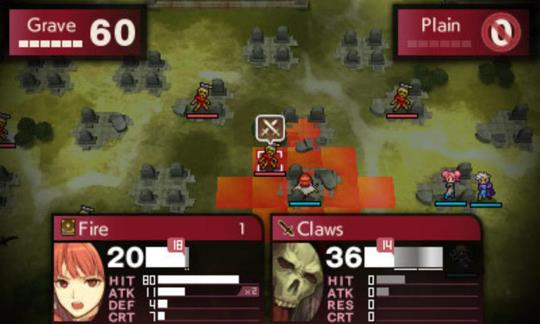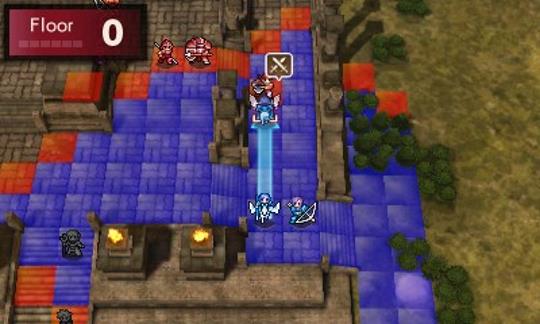Fire Emblem Echoes: Shadows of Valentia

As a wannabe games critic I often find myself conflicted with being late to a series. I missed that initial cultural splash, that purity of form that comes with an initial idea. This means what I experience could communicate a very different idea of what a property is than what those fans from the beginning saw as the series identity. I wrote something about this recently on GamersWithJobs in the article The Spirit of Things. What I latch onto in a particular iteration may be met with displeasure by others.
If you’ll recall, I was absolutely smitten with Fire Emblem: Awakening’s pairing mechanics. It would seem, however, that this very feature and its importance is divisive. Many fans of the older games are not so taken by the “waifu simulator” – and given my own discomfort with how far Fire Emblem Fates took it, I can somewhat see why. As such, Fire Emblem Echoes seems much more favorably met by many older fans.
Support mechanics are still present, but they are far less significant. There are no marriages nor progeny, and bonuses don’t seem to be as great as they were in Fates or Awakening. In addition, you can’t literally pair two units into one, an act that would effectively block secondary or paired attacks from foes.
This at first irritated me. Despite my efforts to be objective when playing games, my emotions can often push me towards extreme feelings of negativity when met with opinions and preferences I do not comprehend. I discussed this somewhat in regards to Gearbox Software and the Borderlands franchise some weeks ago.
While reading early impressions from old school fans of how much they preferred the seemingly stripped down version of the Fire Emblem games, my curiosity and mild disappointment transformed to outright rage and dislike. It took some time before these feelings ebbed away to a better understanding. Echoes is, at its core, a remake of the original 8-bit Famicom game Fire Emblem Gaiden. While developer Intelligent Systems worked to update some of the mechanics to better fit modern sensibilities, they eschewed many of the later changes and advancements that would come in later iterations. There is no color-coded weapon hierarchy like in Fates. Spears no longer have an advantage against swords, and swords none against axes.
For the first two Acts of Echoes – about eight or more hours all told – this lack of more complex mechanics makes the game simple and actually reduces the challenge. It isn’t until the third Act that the player is forced to more carefully think about the positioning of their units and the terrain on the map. This is largely because terrain is the only significant modifier on the battlefield, greatly increasing one’s ability to dodge or chances to strike.
The real challenge then comes in the number and power of enemies scattered across the battlefield, and how much more easily they can access superior terrain. Players can gain an even greater advantage by making use of armories in villages and improving on their equipment, but the improvements are minor compared to the gains of higher ground or the cover of trees.

Echoes transforms from an all too easy tactical game with limited decisions to an unreasonably challenging mountain to climb with limited options seemingly “overnight”. After plowing through enemy lines the player is now forced to restart and retry fights over and over, reloading old saves as seemingly inconsequential choices lead to the felling of two or three key units.
It’s not communicated clearly through the game’s design, but I imagine the Turnwheel was added by Intelligent Systems as a sort of acknowledgement of the increasing challenge and difficulty to come. Plenty of cogs – a resource the Turnwheel relies upon – can be discovered in villages, castles, and dungeons before it is really necessary, which unfortunately means the player may never make use of the tool until about hour ten or twelve. This risks the mechanic being forgotten entirely.
Yet it is the Turnwheel that is, perhaps, the one addition that I’d love to see make its way into future games. Each use costs a single cog. It can undo a single action or whole turns, rewinding as far as the start of the battle. Too many foolish decisions and the player runs out of cogs, forced to either watch as their mistakes carry with them great losses or choose to reload a save once more.
Which is what makes the Turnwheel such a great inclusion. It allows the player the opportunity to minimize the cost of mistakes, taking a handful or a whole bucket of actions back without forcing a complete reset of the fight. The flow is uninterrupted as the battle continues onward. Even if two or three whole turns are reset, there’s no title screen, no loading, and no resetting of unit positions. The player is still in the battle.
However, those chances to rewind are finite, meaning a player has to be careful and decisive as to when they can roll back their choices. Did you perhaps miss one single strike? Is it worth rolling back to make sure that character’s action is not a waste? Or do you save your cog for a potentially devastating round where the foe slaughters your own troops?
The inclusion of the Turnwheel also reveals the game’s weakness. The difficulty only exists if the computer is given an obviously greater advantage. Superior terrain, the ability to spawn new enemy units (that can sometimes teleport!), higher ground and forcing the player through bottlenecks. Most often the only strategy is to coax enemy units forward, playing more cautiously and conservatively. Due to all the bottlenecks in a map, it is possible that many units will barely see combat while others soak up all the experience.
Of course, these overwhelming odds are no doubt an opportunity to some. Rather than having to make meta decisions about which characters should be paired together, players can simply look at the individual strengths of each unit and make careful decisions that coerce the computer into making foolish mistakes. This is certainly rewarding in its own right, but were it not for the Turnwheel the reward would be diminished by the ever-growing shadow of frustration and resets.

While the Turnwheel acts as Yin to the map design’s Yang, there is nothing that truly saves the many dungeons and caverns from being dull slogs. The design of each labyrinth is plain, relying on branching paths like tentacles spreading in every direction. Monsters patrolling each hallway can be avoided, but not without significant risk of attack. Each of these battles is little more than padding, a bland and featureless battlefield with a great number of foes that mostly soak up time rather than hit points.
That the final Act of the game is devoted to nothing more than one long dungeon is enough to illicit a wary sigh. While the foes in all other dungeons are mere fodder, in this last stretch of gameplay the player is forced to take up arms against more challenging foes. Now there is risk of using the Turnwheel, and in a dungeon the player does not regain those cogs until they’ve resurfaced into the light of the sun.
A resurfacing that does not occur in the final dungeon, meaning the final battle – a most challenging one that literally hides certain information and facts necessary to be victorious – must be met at an even greater hindrance.
Of course, this won’t be true for all players. Some players may be good enough to reach the climactic confrontation with all of their cogs intact. Of course, I’ve spoken to other, more experienced players that have struggled through the first two Acts that I steam-rolled over. Imagine, then, how much more challenging the end will be?
If I were forced to compare, I’d still say Fire Emblem Echoes was better than the majority of Fates simply due to the clarity of vision. I am much more likely to replay it, even though I’d argue Conquest has the better campaign – a challenging and frustrating one by the end due to the lack of grinding. If only it had the Turnwheel!
Still, it is such a stripped-down version of the mechanics that I might best recommend it to newer players that want to experience that challenge Birthright will lack while getting a basic idea of what Fire Emblem is. It begs the question, though, of what such new players will then perceive the next iteration as? Will they welcome the weapon hierarchy? How about those relationship mechanics? Will the Turnwheel carry over?
I suppose we’ll find out in 2018 when the new entry is released on Switch.


